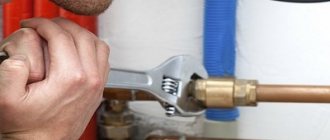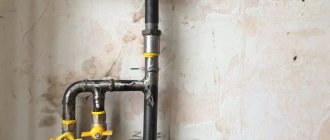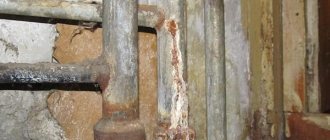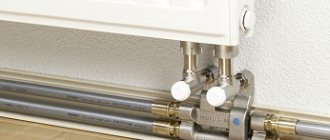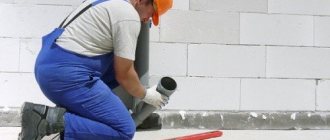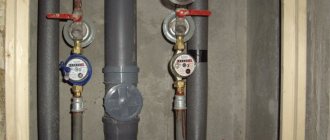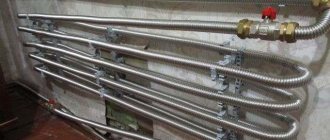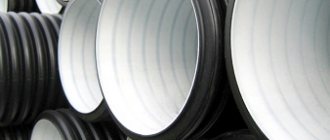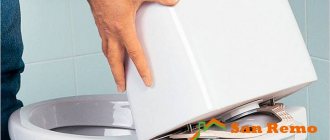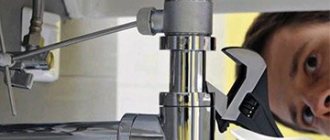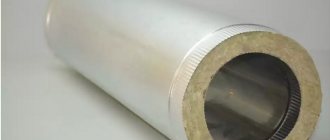Is it legal to ban corrugation for geysers?
Having replaced the old pump with a new one, the gas service refuses to connect it, since the use of corrugated pipes is now supposedly illegal. They CALL for new pipes for discharge from galvanized steel to be ordered from a certain company. Is all this legal or another arbitrariness of the monopolists?
Regarding the corrugations, you are definitely right, since the surface of the smoke exhaust duct must be smooth. I know that there is a regulatory act, but I couldn’t find it in my database. Request in writing those who refuse you. Or search on the Internet for a topic such as “discharge of gas combustion products.” Requirements for the manufacture of chimneys from a specific person are illegal, since this is contrary to antimonopoly legislation.
if there is a corresponding certificate for corrugation, why not? I installed a ball valve for my gas, taking a copy of the certificate of conformity. There will be something to wave in front of the gas workers’ noses! and as for contradictions to antimonopoly legislation. Who complies with it (the legislation)?
Thanks to everyone who responded! Regarding the smooth surface, I saw these pipes and they are made so clumsily that that surface cannot be called smooth, just like the surface of the corrugation, and the zinc compounds themselves, when heated, are not useful for the body. But in antimonopoly legislation, no way the actions of the gas service are not characterized, because they also have a monopoly on the provision of their services. Regarding this, a new question is: do I have the right to refuse this type of service, and what follows from this?
Excuse me, from what services?
From the services of a gas service that supposedly serves me, but in fact cannot repair imported pumps because it does not have spare parts for them and does not even know the structure of this equipment! But they regularly charge a fee for preventive maintenance (by the way, it is not a small fee ) they are on time. Gas service is not a gas supplier for which I regularly pay? And with such prices for their services, it is more profitable for me to periodically buy new gas equipment!
You do not have the right to refuse the services of a gas service for servicing VDGO. Gas is not like water or heating, where in the event of an accident only you and the neighbors below will suffer. If you refuse service, your gas supply may simply be cut off.
One of the most common devices that can provide uninterrupted hot water supply to a home is a gas water heater. It does an excellent job of heating any volume of water in the shortest possible time. At the same time, modern modifications allow you to clearly set the required temperature and automatically turn on and off in accordance with the operating mode of the water point.
Gas-powered instantaneous water heaters are quite economical and safe to use. The only inconvenience is the need to organize high-quality removal of combustion products. This problem can be solved once and for all only with the help of proper installation of an exhaust pipe for a geyser. When choosing the parameters and configuration of the smoke exhaust system, you must be guided by the manufacturer’s instructions and current regulatory documents.
Act on unauthorized gas connection
Officials of gas services have the right to draw up this act. It must have the following elements:
- Information about the official who compiled it.
- Information about the offender.
- Information about connecting to networks bypassing the meter, illegal installation of gas equipment, the extent of natural gas theft, etc.
- Information about sanctions imposed on citizens.
- Orders to eliminate violations.
- Date of document preparation and information on appeal methods.
The citizen faces punishment in any case. However, its specific type depends on the situation in which a particular violation was detected.
A sample act can be downloaded here. ⇐
Regulatory requirements
According to the table of definitions NPB 252-98, the exhaust pipe for a gas water heater is the connecting pipe for the smoke exhaust pipe of the device and the smoke duct. Accordingly, it transports gas combustion products and must meet the requirements for chimneys. Failure to comply with them can lead to gas pollution in the room and carbon monoxide poisoning.
All requirements for chimneys are set out in the following regulatory documents:
- NPB 252–98;
- Rules for the production of pipe and furnace works VDPO;
- SP 42-101-2003, Appendix G
- SP 60.13330.2012, which is an updated version of SNiP 41-01-2003 (replacing SNiP 2.04.05–91).
The main provisions that directly relate to smoke removal from household gas water heaters boil down to the following points:
- The cross-sectional area of the exhaust pipe is taken to be no less than the cross-section of the outlet pipe of the unit;
- It is necessary to ensure complete tightness of the chimney, its resistance to corrosion and high temperatures up to 200 °C;
- Laying connecting pipes through living rooms is prohibited;
- The vertical section of the exhaust pipe at the outlet of the column must be 500 mm high, in some cases it can be reduced to 250 mm;
- Connecting pipes should be up to 3 m long in new buildings and up to 6 m in existing ones;
- It is allowed to use no more than 3 turns with a bend radius no less than the diameter;
- The exhaust pipe is installed at a distance from the ceiling or wall made of non-combustible materials of at least 5 cm, if they are combustible or difficult to burn, then at least 25 cm. The distance can be reduced to 10 cm by taking protective measures in accordance with SP 42-101-2003;
- If the connecting pipe for a gas water heater passes through an unheated room, then thermal insulation must be used;
- The exhaust pipe must be laid with a slope of 0.01 or more towards the appliance.
Advantages of a corrugated pipe hood
For the manufacture of an exhaust pipe the following can be used:
- standard (straight) pipes made of galvanized or enameled steel. Steel pipe can withstand high temperatures and is durable and reliable. However, when assembling a smoke exhaust duct, it will be necessary to use additional fittings to change the direction of the system, which will lead to a decrease in the efficiency of the smoke exhaust and an increase in its cost;
Smoke exhaust duct made of galvanized steel
- corrugated (flexible) pipes. Flexible is easy to install and low cost.
Chimney corrugation
For the manufacture of corrugated smoke exhaust pipes the following are used:
- aluminum. The aluminum pipe is designed for temperatures up to 500°C and can be used for a boiler (column) with low power;
- stainless steel. The most durable material that can withstand higher temperatures.
The flexible stainless steel chimney is distinguished by:
- the ability to withstand temperatures up to 900°C, which allows it to be used to remove combustion products from equipment of any power;
- inertness to acidic environments and almost all chemically active substances formed as a result of combustion;
- integrity. The pipe can be bent in any direction without damage, which allows you to assemble a chimney without additional fittings;
- low cost;
- ease of installation.
Selection of pipeline material
When going to purchase an exhaust pipe, you need to carefully study the installation conditions, know the model of the gas water heater, the diameter of the smoke exhaust pipe and the required lengths of the pipeline sections. It is advisable to stock up on a diagram of the location of the water heater indicating all the distances; this will help you better navigate when choosing the necessary elements and, if necessary, obtain specialist advice.
According to SP 60.13330.2012, connecting and chimney pipes must be made of non-combustible materials with an equivalent internal surface roughness of no more than 1.0 mm. In addition, they must be tight with tightness class B and prevent air leaks at the connections and in places adjacent to the smoke duct. The use of materials such as ceramics and stainless steel is recommended.
SP 42-101-2003 allows the use of roofing or galvanized steel with a thickness of 1 mm or more, flexible metal corrugated pipes and standardized elements supplied with the unit.
It is very important that the material of the exhaust pipe is resistant to corrosion, since condensation can destroy it quite quickly. The smoother the inner surface, the less soot will accumulate on it. The roughness of the outer surface is not standardized, but from the point of view of ease of cleaning, a smoother material for the connecting pipe will be more practical.
Installation procedure
Installation of an exhaust pipe for a geyser made of any material begins with taking measurements and preparing all the necessary elements. In the case of corrugation, the work procedure is very simple. It is enough to take a pipeline of the required length, put it on the smoke exhaust pipe of the water heater and clamp it with a clamp. The free end is inserted into a decorative ring and fixed in the opening of the smoke channel. The main thing here is to ensure that the diameter of the corrugated pipe matches the size of the outlet hole of the column.
For all other materials, you need to prepare the required number of straight and rotary elements that will be inserted into each other, forming the desired chimney configuration according to the principle of a designer. Rotation angles are standard or made individually for specific sizes.
During assembly, ensure maximum tightness of connections. The entry of one element into another must be at least half the diameter. For better sealing, heat-resistant sealant is used. The joints are fastened with clamps and are located outside the ceilings and are freely accessible.
Due to the limitation on the number of permissible turns, the number of possible chimney configurations is quite limited. There are three main options depending on the location of the exhaust vent. Two more can be obtained by mirroring the previous ones.
All requirements and recommendations stated above apply to devices with an open combustion chamber. The standards also allow the removal of combustion products through an external wall without a vertical smoke duct from geysers with a closed combustion chamber and forced release of exhaust gases. In this case, installation is carried out according to the manufacturer's instructions in compliance with the standard distances and lengths of the coaxial chimney specified in SP 42-101-2003.
How to install
The installation of gas equipment should be carried out by a specialist. If you decide to install the pipe yourself, be sure to read all the safety requirements.
Procedure:
- We accurately measure the distance required to install the chimney and apply markings to the wall;
- Purchases clamps for fastening, pipes, an adapter from the column, units for laying pipes through ceilings, a nozzle for covering the street chimney;
- We determine where the pipe will go - into the ventilation duct shaft, or to the street, and prepare the appropriate technological holes;
- We begin the installation of the lower part of the chimney - connect it to the column;
- We connect a pipe with a valve to increase traction;
- We fasten the remaining parts of the chimney with clamps installed every 1.6 m;
- All locations of passages through the floors and roof must be isolated with plugs to prevent fires;
- If the room does not have an exhaust duct inside the wall, it is recommended to use an attachment or root pipe for a gas water heater;
- If steel pipes are attached, it is necessary to provide L-shaped adapters for the ventilation duct and exhaust hood;
- All joints are connected using heat-resistant sealants;
Advice from a professional: To install a hood in a private house, it is better to use coaxial pipes or double sandwich pipes with insulation. In an apartment building, you should not install a chimney yourself at all.
